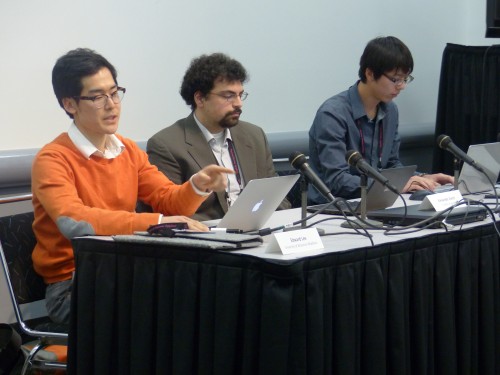
From left to right, Lee talks about his supreme court model, as Alemi and Zeng listen in.
By Tushna Commissariat at the APS March Meeting in Denver
With the amazing variety of interesting talks at the APS meeting yesterday, I couldn’t possibly write up each and every one – I’d have to take today off, and there’s yet more physics to be learned today! In light of that, below is a short round-up of some of yesterday’s speakers and their work.
STEMming international interest
This session, chaired by the APS director of international affairs Amy Flatten, was a panel discussion of what the US could and should be doing to improve visa policies for visiting scientists and engineers, making it a less onerous task. On the panel were Al Teich from George Washington University, Kathie Bailey from the National Academy of Science (NAS) and, interestingly, Matthew Gillian from the visa office of the US Department of State (DOS). Teich has just finished an in-depth study of the hurdles actually faced by STEM researchers and has been campaigning for simple, inexpensive changes to visa regulations that could remove the hurdles. He also pointed out that globally, the competition for talent is intensifying, so “the US needs to facilitate travel for foreign scientists, not make it more difficult”.
Bailey is in charge of the International Visa Office (IVO) at the NAS, and she encouraged people with visa issues – such as very delayed times – to get in touch with them. She said that out of all the cases reported to her office, 63% of applicants were from China and 15% were from India and that these two countries almost always topped her list. Her take-home message was to encourage all applicants to “apply early” – three to four months before you want to travel – and to be honest throughout the process.
Gillian talked about all the measures that the various US embassies world over have adopted over the past few years to make the application process a bit smoother as well as pointing out that while certain administrative changes could be made, other more far-reaching ones would be legislative and out of the hands of the DOS.
Model systems
Another session looked at a whole host of complex, information-heavy social systems that could be studied and modelled to gain more insights into their working. Edward Lee from the University of Wisconsin-Madison has built a model that can accurately predict the voting outcomes of the US Supreme Court. His model, which looked at nearly 40 years of data from 1946 to 2005, provided some intriguing insights into the voting patterns of the nine judges. For example, it found that nearly 40% of votes were unanimous and that the next 20% of votes were 5:4, representing what Lee referrers to as the “ideological right–left split”. And here is the best bit – Lee’s simple model is based on magnetism, where each judge is a magnetic spin!
Alexander Alemi from Cornell University has set his sights on mining the arXiv server to determine its “structure” in hopes to generate more than just scientific papers from it. Using a free Google tool called “word2vec” he has attempted to visualize a 7-year data-set of texts from arXiv in what he calls 300D space – the project is known as arXplor. The code assigns a particular colour to a word in a subcategory, say “particle physics” or “English” or “name”, and then looks for “non-trivial connections” to other words. Finding such key related words is only the tip of the iceberg as far as Alemi is concerned – he hopes to develop this idea to provide an extremely smart search to scientists, flagging up related research and researchers that may not have appeared in general search. You can take a look at arXplor here.
Xiaohan Zeng from Northwestern University spoke about the gender differences seen in scientific collaborations across all of the science disciplines. His work found that women are as collaborative as men – something that has been debated in the past – but they seek new collaborations and publish in smaller teams in come cases. He also pointed out that women, unfortunately, publish less than men overall – a factor that needs to be considered. His research also showed that more gender-diverse research groups tended to publish more and that different subsection work differently, either publishing in large groups or as single researchers.
Take a look at my Twitter feed @tushna42 (and the hashtag #apsmarch) to see my live Tweets from all of the above sessions.
Guidelines
Show/hide formatting guidelines
this text was deletedwhere people live in harmony with nature and animals</q>
Some text